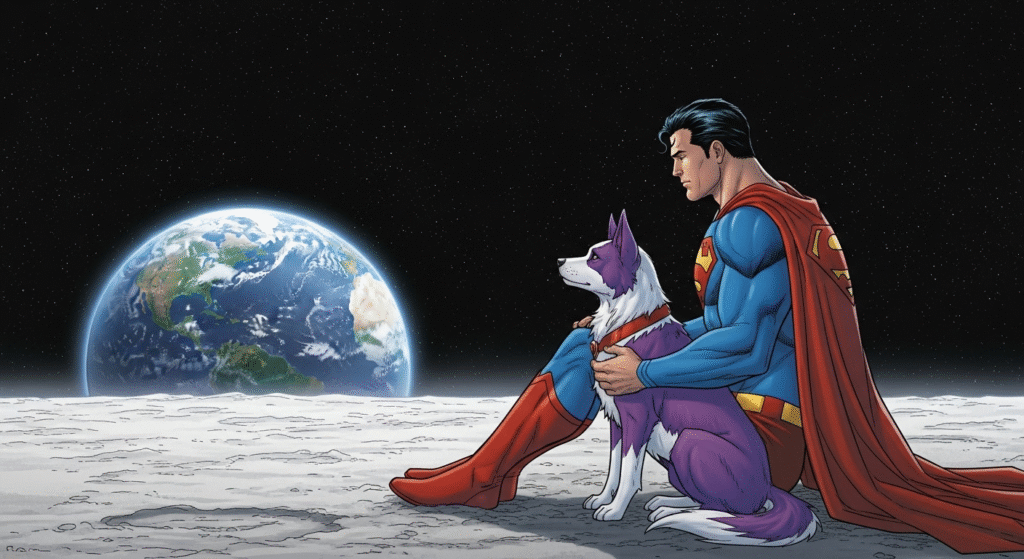▶️CLICK HERE TO WATCH FULL VIDEO
▶️CLICK HERE TO WATCH FULL VIDEO
Superman’s recent reboot — directed by James Gunn and marking the launch of DCU Chapter One: Gods and Monsters — includes two post‑credit scenes that have sparked curiosity. But unlike typical Marvel-style teases, these scenes are intentionally understated, emotional, and character-focused. Here’s what they mean for Superman’s story and the broader DC cinematic universe.
Scene 1: Superman & Krypto on the Moon
Around the midway point of the credits, we see Superman (David Corenswet) quietly seated on the Moon, gazing at Earth while cradling Krypto the Superdog. This visually striking moment is inspired by All-Star Superman, a Grant Morrison comic that resonates deeply with James Gunn’s creative vision (EW.com, GamesRadar+).
🧠 What it represents:
- A visual meditation on isolation and responsibility — even superheroes carry heavy burdens alone.
- A poignant emotional connection rooted in comics, not just exposition or world-building.
- A signal that DCU will prioritize character moments over tradition-heavy world teases .
Gunn deliberately avoided a multiverse or crossover setup here—preferring to give fans a visual reward rather than a narrative cliffhanger .
Scene 2: Superman & Mister Terrific’s Repair Dispute
The final post‑credit scene offers levity: Superman and Mister Terrific (Edi Gathegi) stand before a slightly misaligned building in Metropolis. Superman points out the imperfection, infuriating the genius hero—who storms off frustrated. Superman mumbles, “I can be such a jerk sometimes…” (Sportskeeda).
🤗 Why it’s significant:
- This exchange humanizes Superman and introduces Mister Terrific’s personality early on.
- It’s self-contained, offering a final moment of humor tied to the film’s events.
It reflects Gunn’s philosophy—credit stingers should enhance character, not burden future scripts with obligations (ComicBook.com, SlashFilm).
James Gunn’s Post‑Credits Philosophy
⚙️ A contrast to Marvel:
After navigating Marvel’s Adam Warlock setup in Guardians of the Galaxy Vol. 2, Gunn recognizes credit-scene risks—characters introduced prematurely, italicized into future arcs they don’t fit comfortably into (EW.com).
He explains:
“Sometimes you’re screwing yourself over… unless it’s really going to pay off.”
Thus, Superman’s credit scenes focus on emotional resonance and wit, rather than obligatory franchise plumbing (EW.com).
What These Choices Reveal About DCU
- DC Studios aims for intentional world-building, starting small and building organically.
- The film still introduces new heroes—Supergirl’s chaotic cameo and the Justice Gang establish future threads more subtly (LOS40, GamesRadar+).
There’s no forced tease for upcoming shows (e.g. Lanterns), but DCU maintains potential setups for story arcs grounded in emotion and narrative depth.
🔮 Future Implications for DC Films
🚀 A new tone for DCU:
These credit scenes establish DCU’s commitment to storytelling and tone rather than hype—character over spectacle, authenticity over forced crossovers.
🦸♀️ Supergirl’s Arrival:
Though Supergirl (Milly Alcock) appears mid-story—not in the credit scenes—her chaotic, inebriated entrance searching for Krypto sets up her own 2026 solo film while adding humor to the universe (ABP Live).
👥 Justice Gang Connection:
Mister Terrific and other Justice Gang members appear early enough to feel natural. The credit scene builds subtle rapport rather than echo a forced setup .
🐾 Bizarro Foreshadowing:
Ultraman’s arc hints at the possible emergence of Bizarro. If his imperfect nature triggers mutation, this could become a future arc—not via credit scene, but narrative buildup (Cinemablend).
Credit Scenes Comparison
| Scene | Description | Purpose |
|---|---|---|
| Mid‑credits | Superman + Krypto on Moon | Visual symbolism and tone |
| Post‑credits | Superman & Terrific humour scene | Bonding, levity, no setup |
| Traditional MCU | Cliffhangers setting up future arcs | World-building via promise |
| DCU approach | Reflective, character-driven, optional | Building trust, not hype |
In Summary: What It All Means
- James Gunn is redefining post-credits: Less hype, more heart.
- Credit scenes offer additional entertainment, not narrative contracts.
- This humble approach sets a new direction for DCU: emotionally grounded, character-led, steadily expanding.
- You can expect appearance of familiar faces, but only if it suits the story—not just setup theater.
- If DC extends into Supergirl, Lanterns, Justice League, future stingers will earn their place, not be shoehorned.
✅ Final Thoughts
Superman’s credits mark a philosophical departure from the Marvel-style universe factory. Gunn wants each story to stand on its own, with optional post-credits tied to character or tone—not forced franchise connections. Fans can expect future surprises, but they’ll be built logically—and only if truly organic to the story. In DCU’s new era, substance carries more weight than spectacle.

